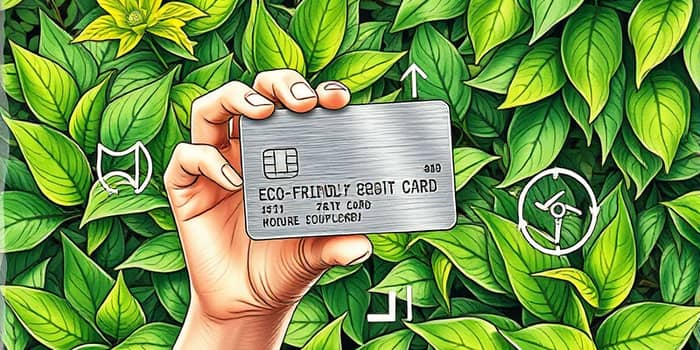In an era defined by climate urgency and social responsibility, every swipe of a credit card can carry profound meaning. More than merely a financial instrument, the modern credit card can serve as a tool to express values, channel donations to worthy causes, and reduce environmental impact.
Choosing the right card is no longer a trivial detail but an empowered decision to align daily spending with broader goals. As consumers demand transparency and accountability, ethical and sustainable credit cards have surged into the mainstream, promising both competitive perks and a meaningful contribution to planetary and human well-being.
Understanding Ethical and Sustainable Credit Cards
At their core, ethical credit cards champion environmental stewardship through thoughtful design and responsible banking practices. These products typically marry material innovation with institutional integrity, ensuring that every cardholder’s purchase supports vetted sustainable initiatives rather than harmful industries.
Such cards are issued by banks and institutions that adhere to rigorous Environmental, Social, and Governance (ESG) frameworks, ensuring investments avoid fossil fuels and prioritize renewable energy, social justice, and transparent governance. By selecting these cards, consumers can actively shift trillions of dollars away from polluting sectors and toward a healthier future.
- Material-Based Sustainability: Recycled plastic, metal, wood
- Institution-Based Sustainability: B Corp, GABV, CDFI, credit unions
- Reward-Based Sustainability: Carbon offsets, nonprofit donations, green cashback
Types of Sustainable Credit Cards
The landscape of eco-friendly credit cards can be divided into three broad categories. First, material-based sustainability focuses on the card’s physical makeup. Choices range from reclaimed ocean plastic to durable metal, each with different life-cycle impacts.
Second, institution-based sustainability evaluates the issuing bank’s policies. B-Corp certification, membership in the Global Alliance for Banking on Values, or Community Development Financial Institution status signals a commitment to ethical lending, transparency, and community development.
Third, reward-based sustainability assesses how spending translates into positive action. Many cards allow users to donate reward points directly to nonprofits or earn cashback for eco-friendly purchases like public transit, renewable energy installations, and carbon offset subscriptions.
Top Ethical Credit Card Options Comparison
Benefits of Choosing Eco-Friendly Credit Cards
Environmental benefits extend far beyond the wallet. Users actively reduce their personal carbon footprint and direct financial flows toward renewable energy projects or conservation nonprofits. Rather than ignoring the material impact of plastics, these cards emphasize minimizing non-renewable resource waste from production to disposal.
On the financial side, many eco-cards deliver rewards and fees comparable to mainstream competitors. Cash back on sustainable goods, points redeemable for carbon offsets, or automatic donations to environmental charities mean that responsible spending can still yield robust consumer perks.
Socially, these cards empower communities by supporting banks that underwrite affordable housing, immigrant services, and worker rights. Cardholders can proudly support community-focused financial institutions whose lending practices foster equity and inclusion rather than predatory lending.
How to Evaluate and Choose the Right Card
When evaluating options, consumers should balance ethical priorities with their personal finances. Factors include regional availability, individual credit requirements, and alignment between rewards categories and daily spending habits. A card with zero fees but limited international acceptance may serve some users better than a premium rewards card tied to fossil-fuel-heavy banks.
- Assess annual fees versus environmental impact
- Verify bank’s fossil-fuel investment policies
- Match rewards to your sustainable lifestyle choices
- Confirm regional availability and acceptance networks
- Review credit requirements and application criteria
Implementing an ESG evaluation can further refine the decision. Review environmental disclosures, social responsibility reports, and governance transparency to ensure the issuer’s values truly align with your own. Many institutions provide public metrics on carbon emissions, community investments, and board diversity.
Market Trends and the Future of Sustainable Finance
Financial institutions are increasingly responding to consumer demand for responsibility, integrating cutting-edge materials like wood composites or reclaimed ocean plastic. Meanwhile, regulators and international agreements push banks toward divesting from fossil fuels and reporting sustainability metrics.
Innovations on the horizon include dynamic cashback rates that reward real-time sustainable purchases, integration of digital wallet carbon calculators, and tiered impact scores embedded in credit reports. Such features promise to make sustainable spending intuitive and metrics-driven.
As global consciousness shifts, the trend toward ethical finance will only accelerate. Credit cards will no longer be measured solely by APR or sign-up bonuses, but by their social and environmental footprints.
Conclusion: Spend with Purpose
Choosing an ethical and sustainable credit card transcends mere economics—it becomes an act of personal advocacy. By voting with each transaction, consumers can reshape banking priorities, compel institutions to adopt greener practices, and channel funds toward environmental and social welfare.
In a world grappling with climate change and social inequities, the simple act of selecting the right credit card can resonate far beyond individual budgets. It signifies a deliberate choice to merge daily habits with long-term planetary health. Embrace that power and spend responsibly—because every purchase today lays the foundation for tomorrow’s world.
References
- https://www.spintheglobeproject.com/ethical-banks-and-socially-responsible-credit-cards/
- https://www.sustainablejungle.com/ethical-credit-cards/
- https://www.nerdwallet.com/article/credit-cards/eco-friendly-credit-cards-what-do-they-promise-can-they-deliver
- https://www.cnet.com/personal-finance/credit-cards/eco-friendly-credit-cards-let-you-earn-rewards-while-helping-the-environment/
- https://www.joinkudos.com/blog/5-best-eco-friendly-credit-cards-of-2025-green-your-wallet-the-planet
- https://greenamerica.org/better-banking/take-charge-your-card/find-responsible-credit-cards
- https://www.nttdatapay.com/blog/eco-friendly-payment-cards/
- https://www.nerdwallet.com/article/investing/esg-investing










